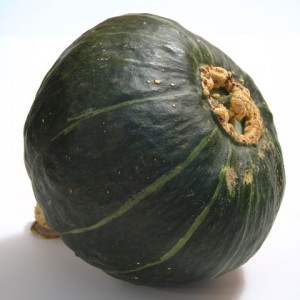All About Hawaii’s Kabocha Squash
 Kabocha squash is a popular vegetable grown on the Islands, as it does well during the fall and winter months, when the rainfall begins to subside. Kabocha squash, which is one of the easiest vegetables to grow in Hawaii, is also one of the most delicious. Unlike summer squashes, which may be prone to fruit flies, winter squashes, such as Kabocha, feature a tougher outer shell that wards off any pesky critters.
Kabocha squash is a popular vegetable grown on the Islands, as it does well during the fall and winter months, when the rainfall begins to subside. Kabocha squash, which is one of the easiest vegetables to grow in Hawaii, is also one of the most delicious. Unlike summer squashes, which may be prone to fruit flies, winter squashes, such as Kabocha, feature a tougher outer shell that wards off any pesky critters.
Because Kabocha squash does so well in the winter, it can be grown outside, instead of under the protective wraps of a greenhouse.
Also called the Japanese pumpkin squash, Kabocha squash features several different varieties, although most varieties features round, dark gray or green skins with lighter colored spots or stripes on them. All varieties of Kabocha squash, however, have the same, sweet, fleshy flesh, making them a popular choice for all kinds of recipes.
Most of squash varieties found in Hawaii were originally brought over from Japan, so it is quite common to see that many Japanese gardeners have perfected the art of growing Kabocha squash in West Hawaii.
There are many catalogs that carry Kabocha seeds to get your squash garden started, including Seeds of Change, an Asian seed catalog. The winter squash seeds found in the Seeds of Change catalog are 100 percent organic; there are also several varieties from which to choose.
The Kabocha squash vines are also quite tolerable, as they can thrive at elevations fewer than 3,000 feet. Plus, you can expect to get your first crop of Kabocha squash in as little as 100 days after planting, providing you situate the plants for full sun exposure each day.
You can grow Kabocha in even dry soil, and the vines may also climb well over rocky locales and even rock walls. There is no need to heavily fertilize when planting Kabocha plants, but mulching them once planted will help seal in the moisture content of the soil if the weather remains dry for an extended period.
It is important to keep an eye on your Kabocha plants as to protect them from insect infestation; particularly the pickleworm. This worm is clear, with small, black spots, and is known to fee on the flowers and fruit of the Kabocha. Most people are able to rid their squash gardens of pickleworm by applying bacillus thuringensis, commonly known as BT, which is a safe way to control insects.
Here is our favorite way to make a great Kabocha squash dish:
- One Kabocha squash (two to three pounds)
- One tablespoon canola or olive oil
- Two tablespoons lemon juice
- One tablespoon soy sauce
- Four tablespoons brown sugar
- One teaspoon ground cinnamon
- One teaspoon ground ginger
Cut squash into one-inch slices, removing the strings and seeds along the way. Lay the cut slices on an oiled baking sheet. Combine the oil with all ingredients and brush the mixture into the squash. Bake for 20 minutes in a 325-degree oven, brushing with marinade once or twice. You may also brown the slices for the last couple of minutes by broiling them.









